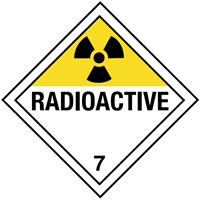
 Print
Print
Chemical Datasheet
URANIUM PEROXIDE |

|
Chemical Identifiers
| CAS Number |
UN/NA Number |
DOT Hazard Label |
USCG CHRIS Code |
|
|
|
|
|
| NIOSH Pocket Guide |
International Chem Safety Card |
|
Uranium (insoluble compounds, as U)
|
none
|
NFPA 704
data unavailable
General Description
Pale yellow crystalline solid. Denser than water. (USCG, 1999)
Hazards
Reactivity Alerts
- Strong Oxidizing Agent
- Radioactive Material
Air & Water Reactions
No rapid reaction with air. No rapid reaction with water.
Fire Hazard
Behavior in Fire: Decomposes to form U 2 O 7 then to UO 3 and oxygen. (USCG, 1999)
Health Hazard
INHALATION: Radiation injuries. EYES: Mild irritation. INGESTION: Injury to capillaries, tubular and glomerular nephritis, hepatitis, glycosuria and acidosis. (USCG, 1999)
Reactivity Profile
URANIUM PEROXIDE reacts rapidly with liquid bromine trifluoride.
Belongs to the Following Reactive Group(s)
Potentially Incompatible Absorbents
Use caution: Liquids with this reactive group classification have been
known to react with the
absorbents
listed below.
- Cellulose-Based Absorbents
- Expanded Polymeric Absorbents
Response Recommendations
Isolation and Evacuation
Excerpt from ERG Guide 161 [Radioactive Materials (Low Level Radiation)]:
IMMEDIATE PRECAUTIONARY MEASURE: Isolate spill or leak area for at least 25 meters (75 feet) in all directions.
LARGE SPILL: Consider initial downwind evacuation for at least 100 meters (330 feet).
FIRE: When a large quantity of this material is involved in a major fire, consider an initial evacuation distance of 300 meters (1000 feet) in all directions. (ERG, 2024)
Firefighting
Excerpt from ERG Guide 161 [Radioactive Materials (Low Level Radiation)]:
Presence of radioactive material will not influence the fire control processes and should not influence selection of techniques. If it can be done safely, move undamaged containers away from the area around the fire. Do not move damaged packages; move undamaged packages out of fire zone.
SMALL FIRE: Dry chemical, CO2, water spray or regular foam.
LARGE FIRE: Water spray, fog (flooding amounts). (ERG, 2024)
Non-Fire Response
Excerpt from ERG Guide 161 [Radioactive Materials (Low Level Radiation)]:
Do not touch damaged packages or spilled material. Cover liquid spill with sand, earth or other non-combustible absorbent material. Cover powder spill with plastic sheet or tarp to minimize spreading. (ERG, 2024)
Protective Clothing
Approved respirator, leather, gloves and protective goggles. (USCG, 1999)
DuPont Tychem® Suit Fabrics
No information available.
First Aid
Call a physician.
INHALATION: Remove from exposure and place on bed rest.
EYES: Wash for 15 minutes with running water. Call a physician.
SKIN: Wash with soap and water.
INGESTION: Excretion is speeded by sodium bicarbonate (10 g in water every hour). Sodium citrate may offer protection to kidneys. (USCG, 1999)
Physical Properties
Flash Point: data unavailable
Lower Explosive Limit (LEL): data unavailable
Upper Explosive Limit (UEL): data unavailable
Autoignition Temperature:
Not flammable
(USCG, 1999)
Melting Point:
239°F
(USCG, 1999)
Vapor Pressure: data unavailable
Vapor Density (Relative to Air): data unavailable
Specific Gravity: data unavailable
Boiling Point: data unavailable
Molecular Weight:
338.06
(USCG, 1999)
Water Solubility: data unavailable
Ionization Energy/Potential: data unavailable
IDLH:
10 mg U/m3
; A potential occupational carcinogen.
(NIOSH, 2024)
AEGLs (Acute Exposure Guideline Levels)
No AEGL information available.
ERPGs (Emergency Response Planning Guidelines)
No ERPG information available.
PACs (Protective Action Criteria)
No PAC information available.
Regulatory Information
EPA Consolidated List of Lists
No regulatory information available.
CISA Chemical Facility Anti-Terrorism Standards (CFATS)
No regulatory information available.
OSHA Process Safety Management (PSM) Standard List
No regulatory information available.
Alternate Chemical Names
- URANIUM OXIDE (UO4)
- URANIUM OXIDE PEROXIDE (UO2[O2])
- URANIUM PEROXIDE


 Print
Print
